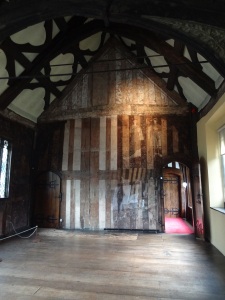In my last blog post, I looked at beds as physical spaces – spaces to be dressed, and protected. Today I would like to delve into the idea of beds as emotional spaces. If (as I suggested in my last post) beds were the stages upon which the dramas of family life were played out then they were also containers for the emotions that these dramas created. Many of these emotions were intensely conflicting. As a married couple, for example, much of your love and intimacy would be contained within the bed curtains. This would be where you prayed together, where you talked through the business of the day, and of course, where you had sex. Yet, the bed could also be the location for arguments, marital violence and rape. The popular contemporary term ‘curtain lecture’ suggests that the bed was associated as much with marital discord as it was with marital bliss.
The childbed was no less emotionally conflicting than the marriage bed. It was the place in which you held your child for the first time, the place that you nursed your infant, the place where you might watch your child sleep, where they would open their eyes for the first time to see your face. It would be a mistake to assume that mothers in history did not experience these events as emotionally as we do now. Yet, even the positive emotions of motherhood must have been tempered by the memories of other emotional events that had taken place within the curtains of that bed. The relatively high likelihood that the infant gripping your finger for the first time would not survive to see its first birthday can only have heightened the complicated emotions that were experienced within the childbed.
Of course, the childbed itself could be viewed with fear and trepidation as well as anticipation. As much as pregnant women and their families looked forward to the arrival of their ‘little stranger’ many also wrote wills as their delivery time approached in case they ‘were call’d away in giving birth to another’.[1] The vast majority of women would have known at least one close friend or family member who had died in childbed. The autobiography of Yorkshire gentlewoman Alice Thornton really brings home the complexity of interweaving emotions in the early modern birth process.[2] Alice wrote in great detail about the birth of her fifth child, Robert, in 1662. Robert was her third son, her first son had been born breech (feet first) and had died within half an hour of being delivered. Her second, William, survived only two weeks before succumbing to smallpox. Of her other four pregnancies (one of which had ended in miscarriage) only two of Alice’s babies were still alive when she went into labour with Robert. Already, then, Alice’s childbed must have been the container for a maelstrom of conflicting emotions.
Sometime after the delivery Alice began to haemorrhage violently. Her autobiography records that there were ‘such excessive floods all that night, that it was terrible to behold to those about me.’ Alice was so ill that she was ‘without hopes of life; spirits, soule and strength seemed all gone from me.’ So certain were they that she was going die, Alice’s ‘deare husband, and children, and friends had taken theire last farewell.’ Alice’s childbed, where she had recently brought a new life into the world, was about to become her deathbed. Nor was this an unusual situation. Alice was, in fact, saved by a powder that she had prepared herself and had used on other women in the same situation as she now found herself in.
The bed contained all of these emotions. It was already a symbolic object – the bedstead, the mattress and the bed dressings signified adulthood, household, and family. Yet, as family members were conceived, born, nursed through illness or died within its curtains the bed acquired layer upon layer of emotional significance. The memories of saying goodbye to a parent within its curtains, as Alice Thornton’s children had, the memories of nursing a child better from smallpox, of losing another child, of a marital consummation, or a marriage-changing row – these memories and their associated emotions were contained within the bed curtains. And these are just the exceptional memories. The bed also had potential to be the site of much more everyday memories and emotions – of warmth and comfort, of worry and bone-aching weariness. The bed was not just the largest and most expensive piece of furniture that most people owned, it was the emotional heart of the household.
Recommended Reading
Sasha Handley, Sleep in Early Modern England (London: Yale University Press, 2016) particularly chapter four ‘Sleeping at Home’
[1] Will of Rebekah Bateman, dated 8 April 1787 (Beinecke Rare Book & Manuscript Library, Yale University).
[2] The Autobiography of Mrs Alice Thornton of East Newton, Co.York (Elibron Classics, 2005).



 Temple Newsam House, Leeds
Temple Newsam House, Leeds
 Early 19thC slum dwelling in Manchester
Early 19thC slum dwelling in Manchester
















